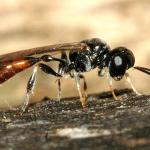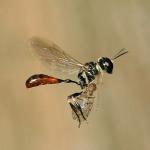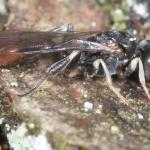A small, black and red solitary wasp. Identification keys are given in Yeo & Corbet (1995), Lomholdt (1984) and Richards (1980).
Widely recorded from England, Wales, Scotland and Ireland. Overseas this species is found throughout Europe eastwards to Mongolia and Japan. Status (in Britain only)
This species is not regarded as being scarce or threatened.
Found in a wide variety of open, sunny habitats associated with its feeding and nesting sites and prey habitats.
Univoltine, May to August .
In Europe nest cells are reported as being stocked with a range of small Diptera such as Mycetophilidae, Chironomidae and Culicidae, together with Homoptera, Psocoptera and Psyllidae. In Britain, prey collected appears to be mostly Psocidae (Lomholdt 1984).
This species is a stem nester and has been found nesting in the stems of a wide range of plants including ash, bramble, elder and reed. Females will either excavate their own nests or make use of existing cavities such as old beetle borings. If there is space, short side branches off the main tunnel may be constructed. Each nest may hold up to 13 cells.
None recorded
None recorded from Britain. In Europe, recorded parasites are Omalus auratus (Hymenoptera: Chrysididae), Torymus armatus (Hymenoptera: Torymidae), Enclisis macilenta and Bathythrix fragifis (Hymenoptera: lchneumonidae) and Oebalia minuta (Diptera: Sarcophagidae).
2005




